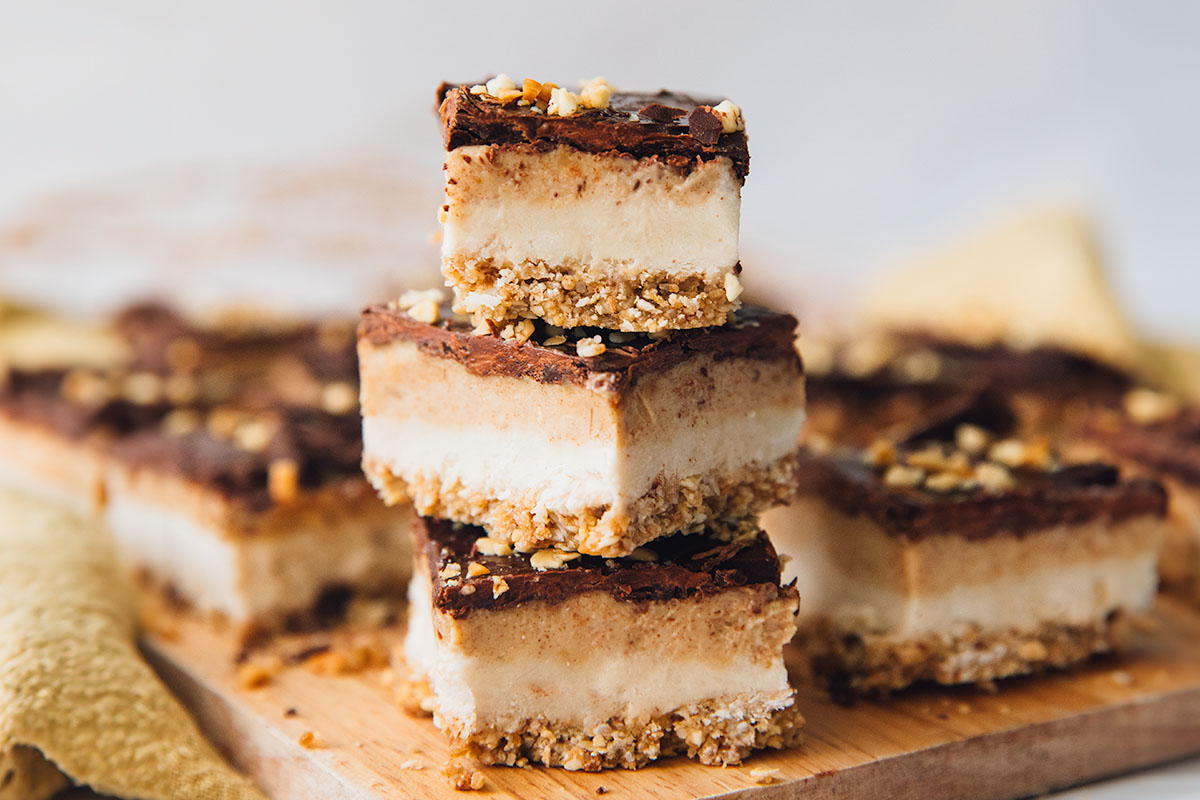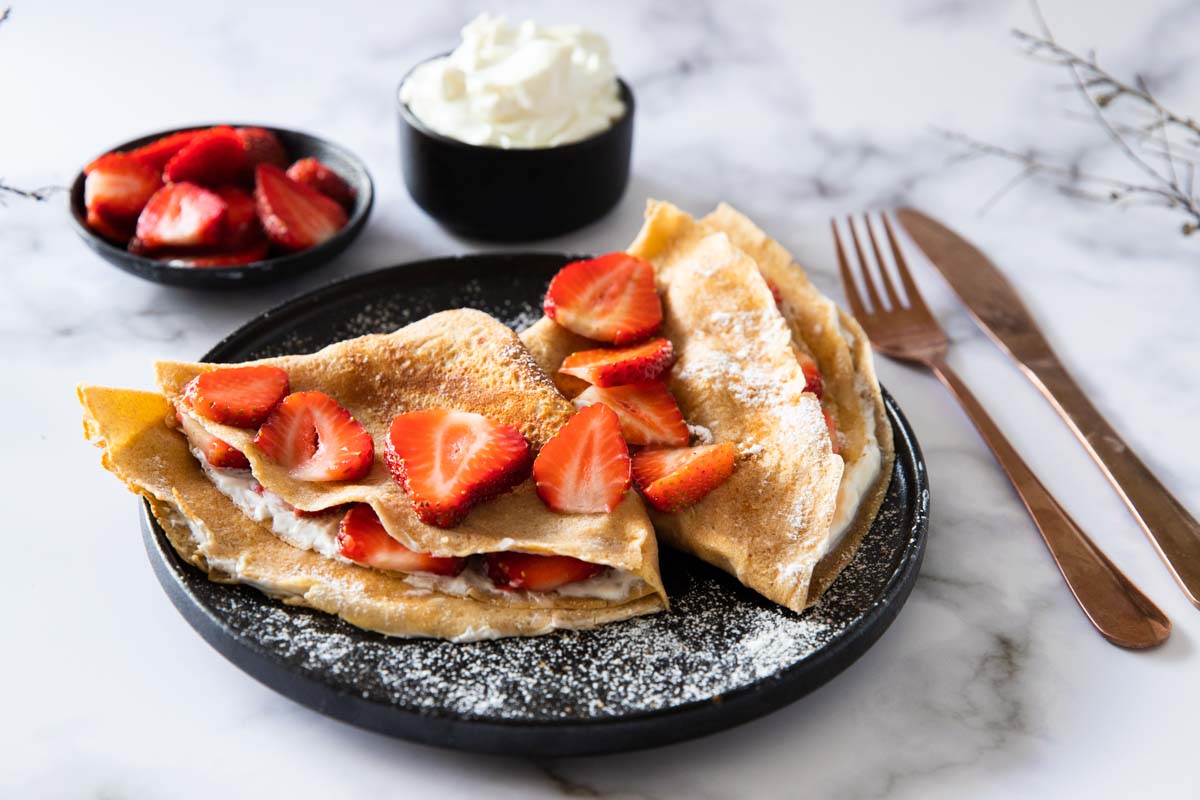Tender, poached apples are hollowed out and stuffed with a caramelised walnut filling then topped with coconut yogurt. This is our vegan, breakfast-friendly take on the popular Bosnian dessert, tufahije.

Country Number 21: Bosnia & Herzegovina
It’s exciting to reach another country in this challenge that Ihave actually been to. Researching and cooking a dish from Bosnia and Hezegovina evoked all sorts of nostalgia and a serious bout of the travel bug.
My time in Bosnia and Herzegovina may have been short, but I quickly grew fond of this fascinating country. After spending the week on a yacht in Croatia for a work trip (rough, I know), a friend and I spontaneously jumped on a bus to Mostar.
We ended up spending the next few days there, exploring this enchanting historic city and some of the surrounding areas. Mostar is most known for the iconic Stari Most, a stunning arched bridge that since the medieval age has been destroyed and reconstructed several times.
Every year, locals gather together for the annual bridge diving competition. We just happened to be in Mostar at the exact time this competition was held. It really was an experience I will never forget, joining the excited crowd as we watched brave divers leap 24 meters off of the old bridge into the river below.

Whilst I can recall the memories of the diving competition like it was yesterday, I sadly can’t recall many of the specifics of the food I ate whilst in Bosnia. This is quite a rare occurrence, as most the time what I remember the most about a place is the food.
Attributing to this was most likely the fleeting nature of my visit to the country, along with the fact that Bosnian food is such a mix of cuisines. As such, I enjoyed revisiting Bosnia cuisine in this challenge, discovering what I had and hadn’t eaten during my time in the country.

History of Bosnian Cuisine
Bosnia’s turbulent history has had a big impact of its cuisine. It has been a meeting point for different nationalities for many years now, and these have all left a distinct mark on the cuisine.
After the collapse of the Roman Empire, Bosnia developed into a kingdom of its own. The region was taken over by the Ottoman Turks, who ruled for around 400 years. After World War II, Bosnia became part of Yugoslavia. In 1992, Bosnia finally declared their independence once again and were recognised as their own country.
The most prominent influences on Bosnian cuisine have been Turkish, Arabic, Austro-Hungarian and Greek. Similar to its European neighbours, meat is very common and plays a key role in many typical Bosnian dishes. Thankfully, generous portions of vegetables are also served.
A lot of Bosnian dishes use spices, and sauces often consist of the natural juices of the vegetables or meat being cooked. Although vegetable-centred traditional dishes are less common, there are enough options for vegetarians to get by.

Popular Dishes in Bosnia Cuisine
- Burek– Burek was brought over from Turkey and is now one of the country’s most popular snacks. Similar to Byrek from Albania, Burek consists of flaky pastry with a filling of meat, cheese or spinach.
- Klepe– The Bosnian version of ravioli. These dumplings come with a variety of fillings, including cheese and are topped with a garlic sauce or yoghurt.
- Tufahija– A popular treat to have with coffee, it consists of a poached apple filled with walnuts and topped with whipped cream.
- Sataras– One of the most vegetarian-friendly dishes famous to the capital, Sarajevo. It is a stew made of slow-cooked vegetables such as tomatoes, onions and bell peppers.
- Uštipci- Small, fried dough balls that are often served with savoury foods such as cheese, eggs, vegetables. They can also contain a sweet filling such as jam or honey.
- Bosnian coffee- This is an integral part of the Bosnian culture. The coffee comes strong and black and tends to be served with a cube of sugar or a sweet treat on the side.
- Dolma– Like many surrounding Balkan countries, dolma are very popular in Bosnia. Typically, eggplant, zucchini or capsicum are stuffed with meat or rice and served with a lemon or garlic sauce.

Making Tufahije, a poular Bosnian dessert
I am a little sad that I never got to try tufahije when I was in Bosnia. In fact, I didn’t even know the dish existed until researching for this challenge. No doubt, I would have seen the word tufahije on a menu and had no idea what it was. We love a good poached apple in our household. Often, we will whip up a batch to put on top of porridge. However, we’ve never tried poaching an apple whole and stuffing it with filling. Such a genius idea!
Our take on the traditional Bosnian tufahija
Instead of making tufahije as it is typically served (as a dessert), we’ve made a few tweaks and turned into a breakfast-friendly dish. Oats, chia pudding and smoothies are on constant rotation in our household, so it was fun to mix it up with a different type of breakfast. As per the normal disclaimer, this is not the authentic recipe for the Bosnian treat, but rather our slightly healthier take on it.
Normally, tufahije is made by filling a poached apple with walnuts that have been soaked in milk and combine with butter and sugar. The result is quite a soft filling. We liked the idea of a little more crunch in the dish, so caramelized our walnuts in a pan instead of soaking them.
The other major difference in our recipe is what we served the tufahije with. Traditionally, the walnut-stuffed poached apple is topped with lashings of whipped cream. We lightened ours up by serving it with coconut yogurt. However, you should definitely still serve it with cream if your heart doth desire!


How to make tufahije (walnut-stuffed poached apples)
These walnut-stuffed poached apples are an easy and fairly quick breakfast or dessert to make. In just a few simple steps, these come together.
- Peel and hollow the apples then poach them for around 10 minutes on the stove.
- Meanwhile, make filling by caramelising walnuts in pan in coconut oil and maple syrup.
- Fill poached apples with walnut filling and serve with yogurt or cream.

Ingredient notes for tufahije
- Apples- We’d recommend using large, granny smith apples for this recipe. The bigger the apple, the easier it will be to hollow it out and have lots of space for the delicious filling.
- Brown sugar- For poaching, we always find brown sugar gives the best result as it infuses its flavour into the fruit. However, if you want to make this refined sugar-free, you could use another sweetener such as maple syrup for the poaching.

Serving suggestions for Tufahije
As mentioned, we served our walnut-stuffed apples for breakfast topped with coconut yogurt to keep the dish on the lighter side. However, you could serve it with any type of yogurt, or the traditional tufahija way with whipped cream.

Tufahije (Vegan Walnut-Stuffed Poached Apples)
Inspired by the Bosnian dessert tufahije, whole poached apples are hollowed out then filled with a decadent caramelised walnut mixture, then topped with yogurt or whipped cream! Healthy enough to eat for breakfast, delicious enough to eat for dessert.
Ingredients
Poached Apples
- 4 granny smith apples (peeled)
- 3 cups water
- 1/4 cup brown sugar
- 1 lemon (juiced)
- 1/2 tsp cinnamon
Walnut Filling
- 1 tbsp coconut oil
- 1/2 walnuts (chopped very finely)
- 1/4 cup maple syrup
- 1 tsp vanilla essence
- 1 tsp cinnamon
- Pinch of salt
Topping
- Coconut yogurt (or use regular yogurt/ cream)
Instructions
- Take peeled apples, and using a spoon, hollow out the apples. To do this, start at the top and dig out the core, ensuring you don’t dig all the way through. This aim is create a bowl inside the apples for the filling, not a hole.
- Bring water to a boil on the stove. Once boiling, add brown sugar, lemon juice and cinnamon. Stir until sugar dissolves. Turn heat down to a simmer. Add the apples into the water. Cover and cook for 5 minutes, then using tongs, flip apples around and cook for another 5 minutes. Remove apples from water using a slotted spoon and put in fridge to cool.
- Make walnut filling by melting coconut oil in saucepan over medium heat. Add chopped walnuts, maple syrup, vanilla essence, cinnamon and salt to pan. Toss to coat walnuts. Leave walnuts to caramelise for about 6 minutes, stirring occasionally.
- Take poached apples out of fridge. Spoon in walnut filling to each. Top with coconut yogurt (or whipped cream) and enjoy!
Planning on making this tufahije recipe for yourself? Tag me at @polkadotpassport!
Other sweet dishes to try:
- Vegan Coconut Tarts Recipe: A Belize Dessert
- Caramelised Banana Porridge from Benin
- Tufahije (Bosnian Walnut-Stuffed Poached Apples)
Liked this tufahije recipe? Pin it for later!









